Tokyo Olympic Stadium Entry by MenoMenoPiu Architects & FHF Architectes
By Bustler Editors|
Tuesday, Mar 19, 2013

Related
A little while ago, we reported about Zaha Hadid Architects taking the first prize in the New National Stadium Japan competition and the selection of the 11 finalist projects. Here is now another design proposal for Tokyo's proposed Olympic Stadium which didn't quite make it among the final submissions: "The Twist" by French MenoMenoPiu Architects & FHF Architectes.
Project Description from the Architects:
1. A district town
Which must be an excellence tool for the public and for all its participants. Its architecture connects gardens, squares, covered pedestrian streets, gathering spaces and induce new urban comportaments.
Designed as a city fragment, not only as a sport equipment, our stadium is an attractor: innovative and generator of vitality. It is expanding in order to better reach users requirements: proximity, diversity, accessibility. It became a district, naturally sustainable and ecological.
Our stadium concept, unlike other conventional stadiums, is an elliptical spiral which is gradually unrolling and forming the built space with a slope of 2%, serving the 80 000 places (with a visibility angle that grows from 20% in the bottom part to 45% at the top part of the gradens). This disposition aims to offer to the public a perfect visibility from all the gradens. The slope also facilitates the access in the building for people with motor deficiencies.
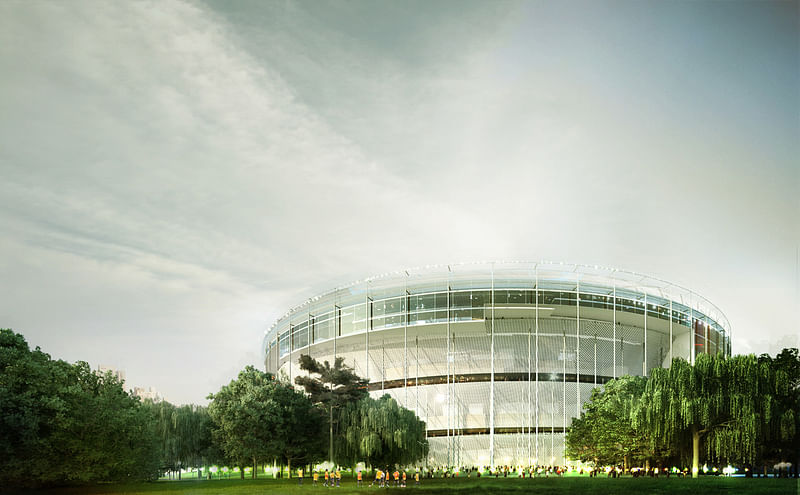
2. Good connections
The stadium and its neighborhood are a integrated part of the city. Due to its good connections with the city, for arrive there, spectators can use public transport day and night to reach and leave.
Big parking areas are provided near the public transport stations connected with the stadium.
The entry and exit of the stadium aremade through three different circuits.
1 / eliptical ramp including an indoor and outdoor circuit serving different gradens (that may includealso the parking under the gradens )
2 / 16 elevator platforms (100 people per platform)for areas of5000 spectators.
3 / stairs in each area of 5000 people of 16passage units.
As a consequence, the stadium can be evacuated in 15 minutes.
The exit circuit is conceived in a manner that evacuates the public in specific areas, separated of the other services.

3. A permanent place to live
Our stadium is the synonym of vitality. Is the area where you can stay and live every day, before and after the event. The viewer is not only the hoste of a stadium, but also an inhabited neighborhood: shopping places, cinema complex, restaurants, hotels, housing, services, sports facilities, gardens and public places. All these transform the stadium froma monument into a familiar place,opened and publicwhich permetsto its visitors to hang out, to talk to meeteach other. New spaces are created, real viewpoints, giving both the lawn and the city. From these urban balconies, you can see for free the show, reach the shops and the restaurants located nearby. This is a radically new way to experience the event: free, being in the stadiumbut feeling that you are in a true living part of the city.
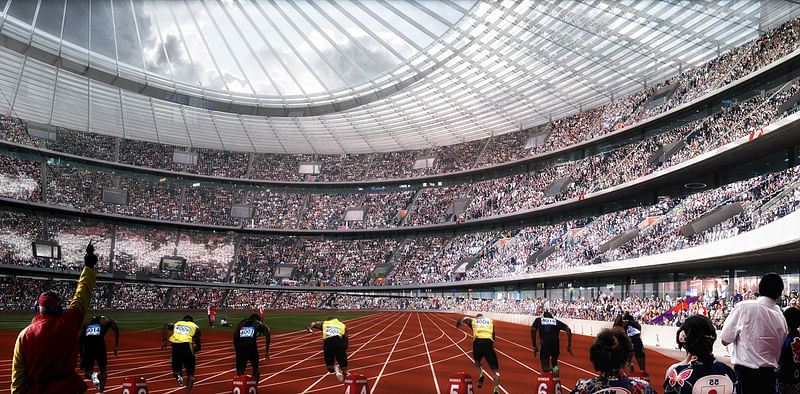
4. Sustainability
It doesn’t consumes energy, but it creates it. The large roof surface becomea solar field, generator of electricity. Rainwater is stored and reused. Energy sources are completing the needs of the stadium and of the neighborhood. The stadium adapts to new practices. The principles of saving energy and fonctional densification are the most important caracteristics of our project.
The superstructure is divided into two parts: the eliptical spiral which turns and forms the stadium and an periferic exterior structure which allows the gradual insertion of facilities like : offices, apartments, amphitheatres, commercial spaces. This second structure is the support of the extension and for the integration of the stadium into the city.
This structure represents also the financial support of the stadium. The investment is amortized by all the equipments contained by this structure. With our approach we can build one or more hotels, of 3,4 and 5 stars, from 250 to 1000 rooms, apartments, thousand square meters of offices and other equipments which amortize like that very fast the investment.
We simulated a financial assumption, by the creation of 486,000 additional M2 on the perimeter of the arena and its built volume.
The coverage of the stadium is a tridimensional opaque metal structure, covered with opaque and translucent photovoltaic panels, compouned bya fixe part and a mobile part.
The fixed part, elliptical in shape, is covered with opaque photovoltaic cells.
Under its oblique shaped face it is the gallery with technical devices, the access to the stadium lights and the implementation of skyvisions around the perimeter of the ellipse.
The mobile part (circular) consists of retractable blades such as lens focal length, they open and close depending on the weather or according to the needs of the show. Its surface is made by translucent photovoltaic cells.
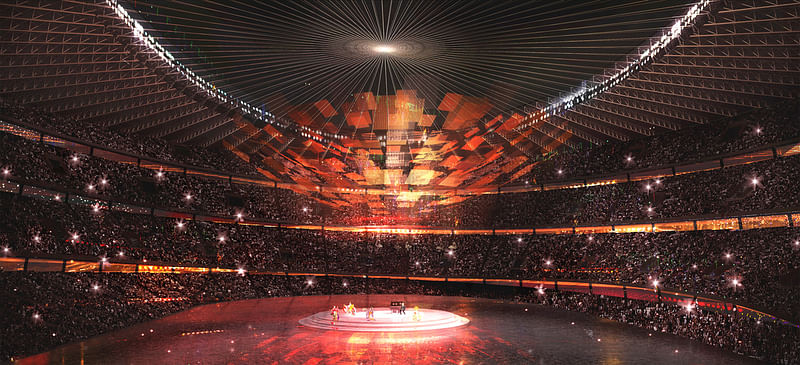
5. It is mythical, it is comfortable, it is multifunctional, it is a window trough the world.
Each sport has its rituals, myths, its profound nature. Each show also. Rugby has its codes , different of football, tennis and of course of those of a concert. Colors, lights, icons, everything is centered on the codes that enhance the pleasure of the moment. At each event, the stadium transformes and adaptes to the spirit of the show.
The infrastructure, given by the slope of the terrain, contains: parking, access services, the pit - including the mechanism for raising and lowering the pitch (on synchronized cylinders) and the edges of the pit, on both sides of the pitch in the direction of the length, supported by the rail mechanism, flyovers covering the lawn when the latter is lowered. The platform, made of4 or 6 sections mounted on tridimensional steel beams , is coated with a floor allowing any charging (crowds, festive activities, earth, ice, water, etc..).
The stadium is sheltered by a mobile roof, which can be adapted for all the situations mentioned above (focal lens are opening and closing - thermal triggered).
It must be more than a stadium economically and socialy profitable. It is designed and sized to accommodate various sports and culture events. Football field, rugby, tennis, basketball, handball, concert halls, operas, congresses, conferences, all find their exact dimensions ..
This multifunctionality changes profoundly the nature of the stadium, it becomes indispensable for the city.
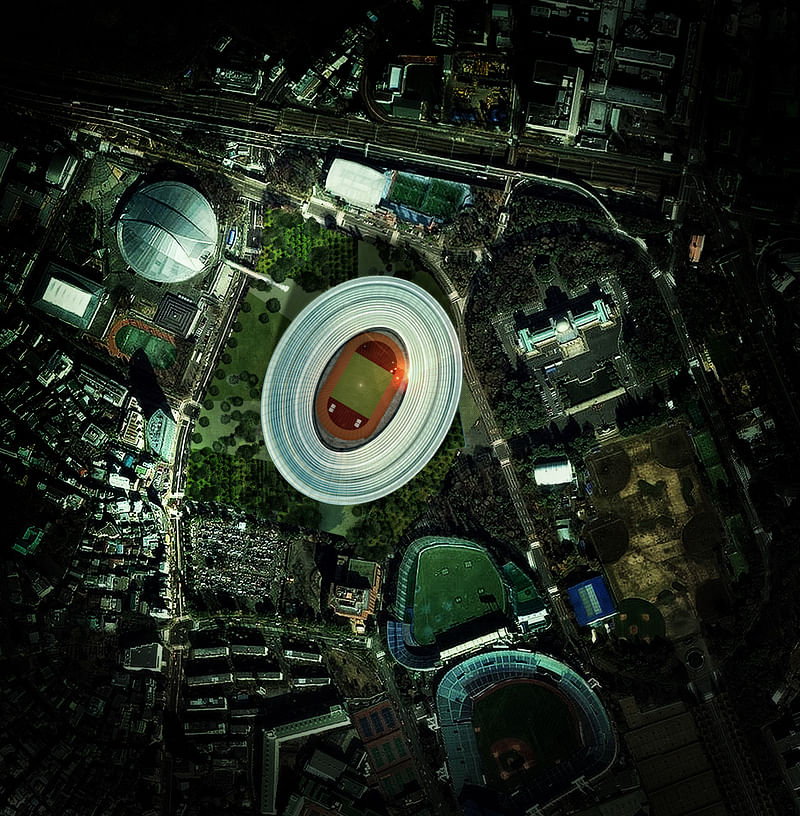
Project Details:
Design: MenoMenoPiu Architects & FHF Architectes
MenoMenoPiu Architects project team: Mario Emanuele Salini, Rocco Valantines, Gilberto Bonelli, Paolo Venturella, Alessandro Balducci, Cristian Gheorghe
FHF Architects project team: Francois Filippi, Gabriele Guastella, Alexandra Popescu
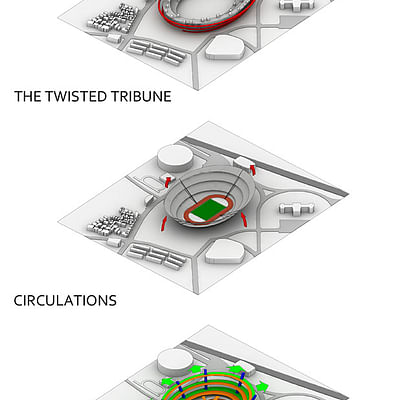

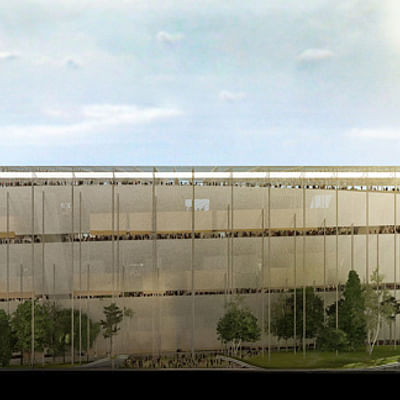


Share
0 Comments
Comment as :